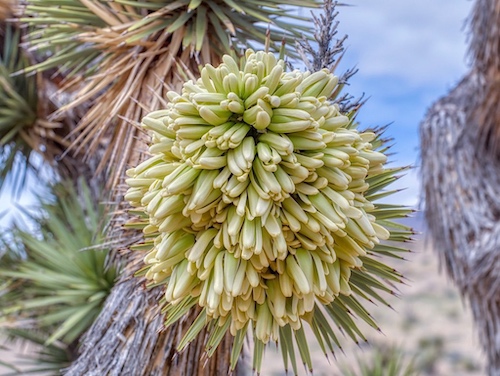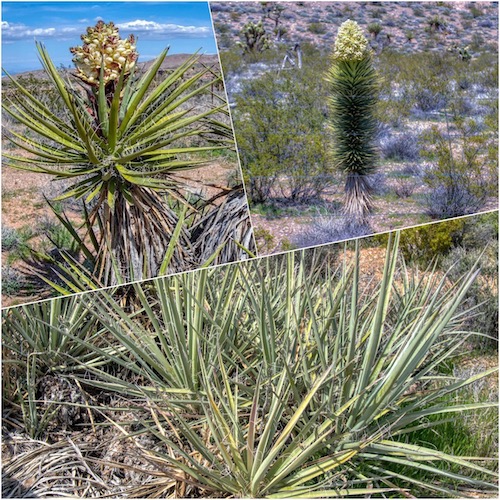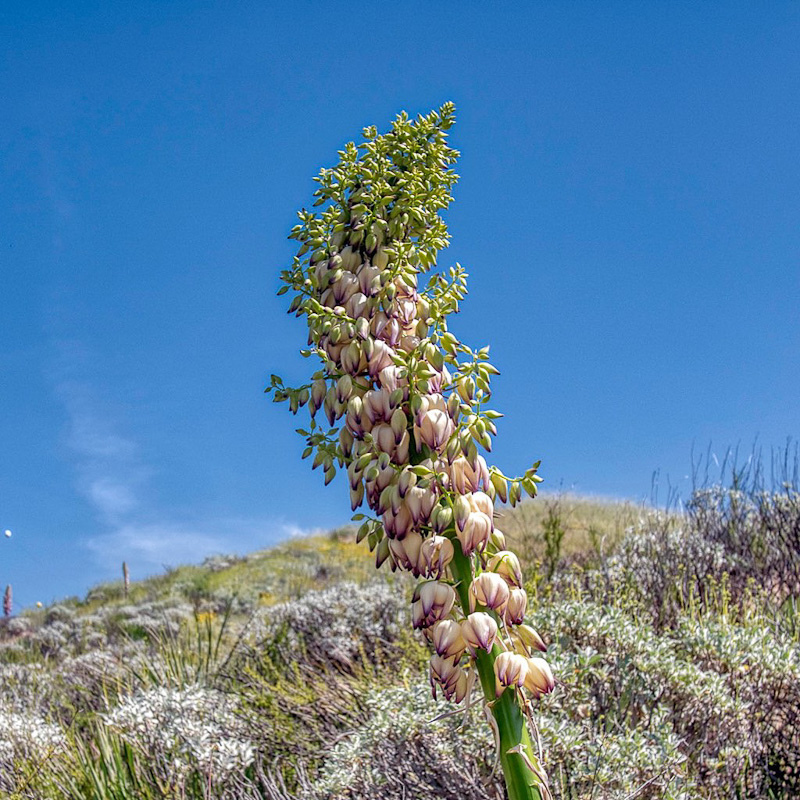
I like to celebrate the return of spring each year by writing about the beautiful flowers I find around me in Las Vegas. It might be surprising to some to know that Las Vegas and the surrounding desert are full of life, flowers and beauty, especially in spring. The wet El Niño winter this year has brought above average amounts of rain to California and Southern Nevada mostly in February. This has resulted in super blooms of poppies in California, a rare wildflower super-bloom in Joshua Tree National Forest and an unusual simultaneous blooming of Joshua trees and Mohave Yucca around Las Vegas. Joshua trees do not bloom every year. Like most desert plants, their blooming depends on rainfall at the proper time. They also need a winter freeze before they bloom and it was cold last winter with a little snow. The blooming cycle of the Joshua Tree is totally dependant on climatic conditions. Depending on the timing and intensity of winter rains, blossoming can occur any time from March to May, and can vary from very sparse to a rare abundance of blossoms in relative wet years as we see this year.
Joshua Trees in Blossom




As you may or may not know, the Joshua tree is in the Yucca genus, found in a very limited range in Southern California and Nevada. The name Joshua tree is commonly said to have been given by a group of Mormon settlers crossing the Mojave Desert in the mid–19th century: The tree’s role in guiding them through the desert combined with its unique shape reminded them of a biblical story in which Joshua keeps his hands reached out for an extended period of time in order to guide the Israelites in their conquest of Canaan. Joshua trees are fast growers for the desert; new seedlings may grow at an average rate of 3 inches (7.6 cm) per year in their first ten years, then only about 1.5 inches (3.8 cm) per year. A young plant will not branch until it blooms. The trunk consists of thousands of small fibers and lacks annual growth rings, making it difficult to determine the tree’s age. If it survives the rigors of the desert, it can live for hundreds of years; some specimens survive a thousand years. The tallest trees can reach about 49 feet (15 m) and have many branches.
Joshua Tree Flowers





The flowers begin as greenish buds clustered near the end of the branches. The six tepals (3 petals and 3 similar sepals) then open up, to reveal a pod-like ovary, surrounded by six stamens, with one pistil. The flowers are waxy, white-to-greenish-white, and 2–3 inches long (5–7 cm). The flowers emit a sweet fragrance reminiscent of coconut.

The Joshua Tree pollen is so sticky that it cannot be carried by the wind. Pollination is accomplished only with the help of the tiny Yucca moth, with which this species has evolved a symbiotic relationship. This moth (Pronuba yuccasella) collects the pollen from a number of flowers and then chooses one flower as a home for its offspring. It deposits the pollen on the flower’s stigma in the process of laying eggs in the flower’s ovary. The newly hatched larvae will feed on the seeds (consuming only about 20 out of 200 in each ovary).
Mohave Yucca Flowers



The Mohave Yucca (Yucca schidigera) is a small unbranched tree, usually with dead leaves around the trunk, growing as tall as 16 feet (5 m). The yellow-green, thick leaves are much longer than the Joshua tree, 1–5 feet long (30–150 cm), spirally arranged. As you can see above, the flowers are a beautiful creamy white, with a purple tinge on the sepals if out in direct sun, produced in a cluster 2–4 feet (60–120 cm) tall at the top of the stem. The fruit is an elongated berry, up to 5 inches (11.5 cm) long. I truly think this is one of the most spectacular desert flowers.
Identifying Yucca Plants


Sometimes when you see a single Yucca plant alone, especially if it is young, it may be difficult to identify. I have included the above comparison photos to help with identification. Joshua Trees (Yucca brevifolia) are pretty easy to spot as adults since they are tall and branched. Younger plants can have a single trunk and can be identified by their short leaves, hence the Latin name breviola. Mohave Yucca (Yucca schidigera) has longer yellow-green leaves, 1–5 feet long (30–150 cm) with a single trunk, usually covered in dead leaves. Banana Yucca (Yucca baccata) also has long leaves, 1–3 feet (30–100 cm) long with more of a blue-green color, and short or nonexistent trunks. It flowers a little later in the spring, starting in April to July depending on locality and altitude. It gets its common name “banana yucca” from its banana-shaped fruit. The specific epithet “baccata” means “with berries.” Banana yucca is closely related to the Mojave Yucca and they are often interspersed where their ranges overlap, as in Red Rock Canyon. Surprisingly, there are few Joshua trees actually in Red Rock Canyon at present due to a string of wildfires. The best place to see living Joshua Trees are on the road leading to Red Rock Canyon from Las Vegas.
California Yucca Blooms


Since I was recently in California, where they are having wildflower super blooms, I thought I would include a blooming California Yucca example. Chaparral Yucca (Hesperoyucca whipplei) is native to southern California and Baja California, Mexico, where it occurs mainly in chaparral, coastal sage scrub, and oak woodland plant communities at altitudes of 0-8000 feet (0–2500 m). The single inflorescence grows extremely fast, and reaches 3-10 feet (0.9–3 m) tall, bearing hundreds of elliptical (bell shaped) white to purplish flowers on a densely branched panicle, covering the upper half of the inflorescence. Hesperoyucca was described as a genus by Georg Engelmann as long ago as 1892, but it has taken recent DNA analysis to confirm that they are genetically distinct from Yucca. Yucca species such as the Yucca whipplei have been documented to have been used as a fiber and food source by Native Americans in the western United States prior to European settlement efforts. The leaves were soaked and woven into cordage, baskets and sandals as far back as 5000 years ago by the Serrano people. Native Americans made flour from the seed, ate the flowers and roasted the young flower stalks. Roots contain saponin, which produces copious suds when soaked.
Beaked Yucca (Yucca Rostrata)

A few years ago, there was a display of beaked yucca used as a pretty spectacular ornamental garden. They had dozens of these plants in full bloom. Sadly, shortly after they bloomed, the trees were were removed and exchanged for cactus. Beaked Yucca (Yucca Rostrata) is native to Western Texas and Northern Mexico, a tree-like yucca used as an ornamental and slow-growing evergreen. Known to be one of the toughest trunk-forming yuccas, Yucca rostrata is drought-tolerant and a popular garden attraction in the UK, US, and Canada. It will grow happily in the hottest, brightest part of the yard; it will also grow on soil where nothing else will. There are over forty yucca species. Yucca rostrata, or Big Bend yucca is often confused with a similar member known as Yucca rigidia, which is a slow-growing, medium-sized tree-like yucca, native to Mexico. Yucca rigidia is commonly found in nurseries where xeriscape plants are sold. Yucca rostrata also has a cultivar called “Sapphire Skies” that produces creamy-white flowers between mid to late summer. It can grow up to 5′ feet tall and resemble a palm tree. The cultivar likes full sun and dry soils, as do all other yucca species. Not sure if these might be the “Sapphire Skies” cultivar.
Blooming Times

Since we drive Highway I15 to Los Angeles frequently to visit our grandchildren, we noticed that the many Joshua Trees after Primm and before Baker were also in full bloom. However, the Joshua trees around Victorville, close to Los Angeles, were not in bloom. Probably a combination of precipitation and elevation differences.
Critters



Around Las Vegas, there are two species of rabbits, the Desert Cottontails and Black-Tailed Jackrabbits. Cottontails are much smaller and have much shorter ears than Jackrabbits, and cottontails have a cottony-white tail. Jackrabbits are larger, have much longer ears, and have a black tail. Cottontails have integrated nicely into the suburbs while Jackrabbits are more comfortable out in the desert. Shrubs generally comprise the bulk of fall and winter diets, while grasses are used in spring and early summer. I saw lots of grass and several Jackrabbits at Red Rock Canyon.

The Side-Blotched Lizard comes in a variety of forms and is endemic in dry regions of western United States and northern Mexico. There were a a fair number running around the day I was at Red Rock Canyon. You can see that something took it’s tail and it is regrowing.


The super-blooms of wildflowers in California has led to an explosion in the number of Painted Lady Butterflies (Vanessa cardui). Butterflies lay their eggs on plants so that the larvae will have something to eat after they hatch. All the rain produced an abundance of vegetation in the desert, which gave painted lady caterpillars plenty of food to munch on. As a result, far more caterpillars than usual were able to survive into adulthood. After the butterflies reach adulthood in the California deserts, in late winter or early spring, they disperse to the northwest, flying without stopping at speeds of up to 25 mph. The insects can travel 240 miles from Lone Pine in the Eastern Sierra to Davis in three days. In this case, some got lost and ended up in Red Rock Canyon in Nevada.


This little white butterfly, the Western White (Pontia occidentalis), is a common sight in the spring and early summer in the deserts around Las Vegas. It is a close relative of the Checkered White Butterfly (Pontia protodice) commonly found across the US. I was actually hoping it was a Yucca Moth (Prodoxidae sp) that pollinates the Yucca flowers seen above, but I had no luck finding the moth.
As always, I hope you enjoyed the post. The environment of our planet is fragile and things that begin far away can affect us where we live. In any case, if you visit Red Rock Canyon to see the beautiful red rocks, look around a little or take a hike, there is a lot to see. I have also added a reference concerning the edibility of Yucca flowers, buds, pods and roots.
References:
Yucca Gloriosa: Spring Landscapes in Las Vegas
‘Rivers in the sky’ are why California is flooding in 2019
Joshua trees are blooming early in the desert. It’s not a good thing — you can thank climate change
Plants and Flowers at Red Rock Canyon
In the middle of a butterfly crisis, California sees a burst of painted ladies
Mass Migration of Painted Lady Butterflies Entrances Californians

